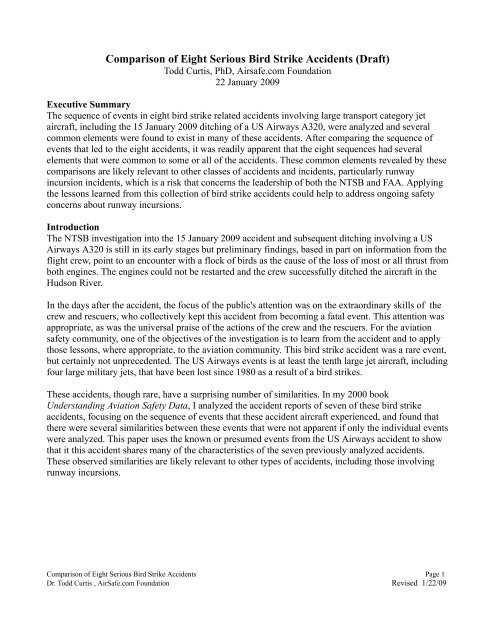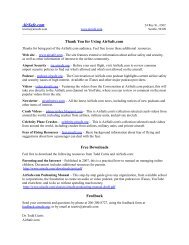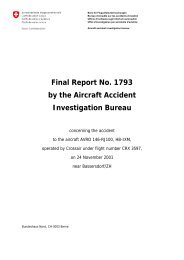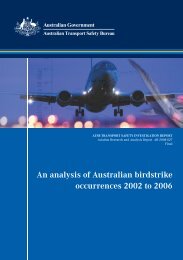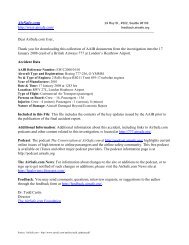Event Sequence Analysis - Bird Strikes - Airline Safety and Security ...
Event Sequence Analysis - Bird Strikes - Airline Safety and Security ...
Event Sequence Analysis - Bird Strikes - Airline Safety and Security ...
Create successful ePaper yourself
Turn your PDF publications into a flip-book with our unique Google optimized e-Paper software.
Comparison of Eight Serious <strong>Bird</strong> Strike Accidents (Draft)<br />
Todd Curtis, PhD, Airsafe.com Foundation<br />
22 January 2009<br />
Executive Summary<br />
The sequence of events in eight bird strike related accidents involving large transport category jet<br />
aircraft, including the 15 January 2009 ditching of a US Airways A320, were analyzed <strong>and</strong> several<br />
common elements were found to exist in many of these accidents. After comparing the sequence of<br />
events that led to the eight accidents, it was readily apparent that the eight sequences had several<br />
elements that were common to some or all of the accidents. These common elements revealed by these<br />
comparisons are likely relevant to other classes of accidents <strong>and</strong> incidents, particularly runway<br />
incursion incidents, which is a risk that concerns the leadership of both the NTSB <strong>and</strong> FAA. Applying<br />
the lessons learned from this collection of bird strike accidents could help to address ongoing safety<br />
concerns about runway incursions.<br />
Introduction<br />
The NTSB investigation into the 15 January 2009 accident <strong>and</strong> subsequent ditching involving a US<br />
Airways A320 is still in its early stages but preliminary findings, based in part on information from the<br />
flight crew, point to an encounter with a flock of birds as the cause of the loss of most or all thrust from<br />
both engines. The engines could not be restarted <strong>and</strong> the crew successfully ditched the aircraft in the<br />
Hudson River.<br />
In the days after the accident, the focus of the public's attention was on the extraordinary skills of the<br />
crew <strong>and</strong> rescuers, who collectively kept this accident from becoming a fatal event. This attention was<br />
appropriate, as was the universal praise of the actions of the crew <strong>and</strong> the rescuers. For the aviation<br />
safety community, one of the objectives of the investigation is to learn from the accident <strong>and</strong> to apply<br />
those lessons, where appropriate, to the aviation community. This bird strike accident was a rare event,<br />
but certainly not unprecedented. The US Airways events is at least the tenth large jet aircraft, including<br />
four large military jets, that have been lost since 1980 as a result of a bird strikes.<br />
These accidents, though rare, have a surprising number of similarities. In my 2000 book<br />
Underst<strong>and</strong>ing Aviation <strong>Safety</strong> Data, I analyzed the accident reports of seven of these bird strike<br />
accidents, focusing on the sequence of events that these accident aircraft experienced, <strong>and</strong> found that<br />
there were several similarities between these events that were not apparent if only the individual events<br />
were analyzed. This paper uses the known or presumed events from the US Airways accident to show<br />
that it this accident shares many of the characteristics of the seven previously analyzed accidents.<br />
These observed similarities are likely relevant to other types of accidents, including those involving<br />
runway incursions.<br />
Comparison of Eight Serious <strong>Bird</strong> Strike Accidents Page 1<br />
Dr. Todd Curtis , AirSafe.com Foundation Revised 1/22/09
In all of the seven accidents that were analyzed for Underst<strong>and</strong>ing Aviation <strong>Safety</strong> Data, birds were<br />
ingested birds into one or more engines during takeoff <strong>and</strong> in three of the accidents, crew actions<br />
directly contributed to the sequence of events that led to the accident. In the eighth event involving the<br />
US Airways A320, the aircraft encountered birds shortly after takeoff, <strong>and</strong> likely ingested birds into<br />
both of its engines. From these eight accidents, two groups of events were identified that should be<br />
part of a bird strike risk assessment. The first group included thirteen events that were directly<br />
involved in one or more of the eight accidents studied, <strong>and</strong> the second group included four events that<br />
were not directly involved in any of those eight accidents, but could be involved in future accidents.<br />
This study includes a brief overview of the event sequence analysis method <strong>and</strong> a discussion of ways<br />
to apply the insights of this study to other aviation safety issues, specifically runway excursions.<br />
This study uses event sequence analysis to develop a risk assessment of a bird strike during takeoff that<br />
leads to a large jet transport accident. An analysis of prior bird strike studies <strong>and</strong> of eight previous bird<br />
related large jet transport accidents (seven resulting in a hull loss) revealed two things. First, flight<br />
crew action played a significant role in the outcome of these accidents <strong>and</strong> second, past major studies<br />
of bird strike effects did not deal with the role of crew actions.<br />
This study examines past bird strike related accidents to create a minimum set of circumstances,<br />
including those involving the role of decision making, that should be included in a bird strike risk<br />
assessment model. This set is not meant to be exhaustive, but rather to serve as a foundation for further<br />
development of a risk assessment model for both bird strike related risks, <strong>and</strong> for other areas of<br />
concern to the aviation safety community.<br />
Past Research<br />
Most available bird strike data <strong>and</strong> research studies focus on the effect that a bird strike has on the<br />
aircraft or on the outcome of the flight. Issues such crew coordination or the adequacy of crew training<br />
are usually not a part of these research efforts. These issues are usually discussed in detail only as part<br />
of an individual accident investigation or incident report. Typical of the major studies is the 1995 FAA<br />
study <strong>Bird</strong> Ingestion Into Large Turbofan Engines. One section described a number of events where the<br />
crew changed the planned flight of the aircraft after a bird strike event but did not discuss the flight<br />
crew’s decision making process.<br />
Information on the human element in serious bird encounters can be inferred from other studies. In<br />
1992, a joint industry <strong>and</strong> government effort, described in FAA Advisory Circular 120-62, investigated<br />
crew performance issues in a variety of rejected takeoff scenarios. Many of the conclusions reached,<br />
such as the need to train crews to make better rejected takeoff decisions, are directly relevant to the<br />
assessment of the risk of bird strikes during takeoff.<br />
Comparison of Eight Serious <strong>Bird</strong> Strike Accidents Page 2<br />
Dr. Todd Curtis , AirSafe.com Foundation Revised 1/22/09
Method<br />
This study relied on official accident investigation reports or other published reports from the<br />
following eight accidents to determine the sequence of events that could lead to a bird strike related<br />
large jet transport accident:<br />
1. 12 November 1975 DC10 USA Rejected takeoff<br />
2. 4 April 1978 737 Belgium Rejected takeoff<br />
3. 20 July 1986* 737 Canada Rejected takeoff<br />
4. 29 September 1986 A300 India Rejected takeoff<br />
5. 15 September 1988 737 Ethiopia Two engine power loss<br />
6. 25 July 1990 707 Ethiopia Rejected takeoff<br />
7. 22 September 1995 707 AWACS USA Two engine power loss<br />
8. 15 January 2009 A320 USA Two engine power loss<br />
*Only event that was not a hull loss<br />
Factual data <strong>and</strong> conclusions of the accident reports were used as a guide to building the event<br />
sequence for the first seven events <strong>and</strong> preliminary NTSB investigation findings were used for the<br />
eighth event.<br />
A Brief Overview of <strong>Event</strong> <strong>Sequence</strong> <strong>Analysis</strong><br />
As the name implies, event sequence analysis involves determining the sequence of events that lead to<br />
an accident. The events include those that directly contributed to the accident <strong>and</strong> those that did not.<br />
<strong>Event</strong> sequence analysis is a potentially useful model for bird strike risk assessment because it can<br />
include human actions <strong>and</strong> environmental conditions that influence the outcome of an aircraft<br />
encounter with birds. <strong>Event</strong> sequence analysis allows the analyst to use some judgment when ordering<br />
the sequence of events. For example, a wet runway may be placed before a crew’s decision to reject a<br />
takeoff because it may be assumed that environmental conditions were considered by the crew before<br />
any takeoff is attempted.<br />
Comparison of Eight Serious <strong>Bird</strong> Strike Accidents Page 3<br />
Dr. Todd Curtis , AirSafe.com Foundation Revised 1/22/09
Figure 1: <strong>Event</strong> <strong>Sequence</strong> Map Structure<br />
Below is the basic structure of an event sequence map for a series of events that lead to a pair of<br />
unique consequences.<br />
<strong>Event</strong> 1<br />
<strong>Event</strong> 2<br />
<strong>Event</strong> 3A<br />
<strong>Event</strong> 4A<br />
Consequence 1<br />
<strong>Event</strong> 3B<br />
<strong>Event</strong> 4B<br />
Consequence 2<br />
In this example, each line represents one event <strong>and</strong> the indentations are a visual reminder that the<br />
events take place in a specific sequence. The rightmost indented event represents the outcome. The<br />
line connecting <strong>Event</strong>s 3A <strong>and</strong> 3B in Figure 1 illustrates that the sequence branches at the point into<br />
two possible directions. The consequences at the end of these different paths can either be the same<br />
consequence arrived at through different sequences of events or they could be different consequences.<br />
In Figure 1, there is a different unique sequence associated with Consequence 1 <strong>and</strong> 2, but both<br />
sequences would share <strong>Event</strong>s 1 <strong>and</strong> 2.<br />
The probability of any one event occurring may or may not be dependent on the sequence of events<br />
that preceded it. Consider the following sequence: (1) the flight crew sees a large flock of birds during<br />
the takeoff roll, but are unable to take any kind of evasive action such as rejecting the takeoff (e.g.,<br />
after V1 but before Vr); (2) after hearing multiple impact sounds from these birds, the engine<br />
instruments indicate a substantial drop in thrust on one engine; <strong>and</strong> (3) the crew rejects the takeoff; the<br />
probability of the second event would be entirely independent of the first event, but the probability of<br />
the third event would be a function of the first two events. This is because in airline operations, pilots<br />
are trained to continue the takeoff if there is a loss of thrust on a single engine after reaching V1, unless<br />
they have reason to believe that a rejected takeoff is a better option than continuing the takeoff.<br />
From my industry experience where I analyzed numerous accidents <strong>and</strong> incidents involving either bird<br />
strikes or rejected takeoffs, I found that the pilots sometimes made decisions based on information that<br />
is not reflected in their cockpit instruments. In the context of bird strikes, that information may include<br />
the visual presence of birds coupled with sounds of impact on the aircraft. There have been cases,<br />
including the 1986 A300 bird strike accident analyzed in this report, where pilot sensations such as<br />
sighting birds, hearing impacts, or feeling engine vibration, led the flight crew to make a rejected<br />
takeoff decision that led to an accident, even though the cockpit instruments correctly indicated that<br />
the aircraft could safely take off.<br />
Comparison of Eight Serious <strong>Bird</strong> Strike Accidents Page 4<br />
Dr. Todd Curtis , AirSafe.com Foundation Revised 1/22/09
Results<br />
Construction of the event sequences of the first seven accidents was based on information in formal<br />
accident reports, <strong>and</strong> there was enough data from the ongoing investigation into the eighth event from<br />
15 January 2009 to construct a preliminary event sequence <strong>and</strong> fit that accident within the context of<br />
the original seven.<br />
Table 1 illustrates some of those similarities <strong>and</strong> differences among the eight accidents. Table 2<br />
contains those events that had a direct effect on the final outcome of the accidents studied. Table 3<br />
contains those elements that may have a direct effect on the outcome of future accidents involving bird<br />
strikes. Figure 2 consists of an event sequence map that is based on the information gathered from the<br />
eight accident reports <strong>and</strong> has the consequences of interest in bold type.<br />
Comparison of Eight Serious <strong>Bird</strong> Strike Accidents Page 5<br />
Dr. Todd Curtis , AirSafe.com Foundation Revised 1/22/09
Table 1:<br />
Similarities <strong>and</strong> Difference in Accident <strong>Event</strong> <strong>Sequence</strong>s<br />
12 Nov 75<br />
DC10<br />
4 Apr 78<br />
737<br />
20 Jul 86<br />
737<br />
29 Sep 86<br />
A300<br />
15 Sep 88<br />
737<br />
25 Jul 90<br />
707<br />
22 Sep 95<br />
AWACS<br />
15 Jan 09<br />
AWACS<br />
Phase of Flight When <strong>Bird</strong>s Hit Takeoff Takeoff Takeoff Takeoff Takeoff Takeoff Takeoff Climb<br />
<strong>Bird</strong>s Seen By Crew Yes Yes Yes Yes Yes Yes Yes Yes<br />
Speed at <strong>Bird</strong> Impact < V1 Vr < V1 Vr Vr < V1 Vr >Vr<br />
Captain Decided to Reject<br />
Yes Yes Yes Yes No Yes No N/A<br />
Takeoff<br />
Cockpit Decisions a Factor<br />
Leading to Accident<br />
No Yes No Yes No Yes No UNK<br />
Comparison of Eight Serious <strong>Bird</strong> Strike Accidents Page 6<br />
Dr. Todd Curtis , AirSafe.com Foundation Revised 1/22/09
Table 2: <strong>Event</strong>s With A Direct Effect on the Outcome of the Accident<br />
12 Nov 75<br />
DC10<br />
4 Apr 78<br />
737<br />
20 Jul 86<br />
737<br />
29 Sep 86<br />
A300<br />
15 Sep 88<br />
737<br />
25 Jul 90<br />
707<br />
22 Sep 95<br />
AWACS<br />
15 Jan 09<br />
A320<br />
1. Engine Ingests at Least One <strong>Bird</strong> X X X X X X X X<br />
2. Uncontained Engine Failure X X X UNK<br />
3. Partial Thrust Loss on One or<br />
X X X Possible<br />
More Engines<br />
4. Full Thrust Loss on One Engine X X X X Possible<br />
5. Full Thrust Loss on Multiple<br />
X<br />
Likely<br />
Engines<br />
6. Aircraft Not Capable of<br />
X X X X<br />
Continued Flight <strong>and</strong> Safe L<strong>and</strong>ing<br />
7. Significant Loss of Stopping<br />
X<br />
X<br />
Capability (tires, brakes, spoilers, or<br />
thrust reversers)<br />
8. Non-Engine System Malfunction X UNK<br />
9. Crew Coordination or Decision<br />
X X X UNK<br />
Problems<br />
10. RTO Initiated With Aircraft<br />
X X X<br />
Beyond V1<br />
11. Airfield Management Actions X<br />
12. Air Traffic Control Actions X<br />
13. Aviation Regulations X
Table 3:<br />
<strong>Event</strong>s That May Directly Effect the Outcome of Future Accidents<br />
14. Crew Relying on<br />
Physical Cues (visual,<br />
auditory, kinesthetic)<br />
15. Procedures for<br />
Transferring Aircraft<br />
Control<br />
16. Loss of Directional<br />
Control<br />
17. Aircraft Fire Before the<br />
End of the Flight<br />
12 Nov 75<br />
DC10<br />
4 Apr 78<br />
737<br />
20 Jul 86<br />
737<br />
29 Sep 86<br />
A300<br />
15 Sep 88<br />
737<br />
25 Jul 90<br />
707<br />
22 Sep 95<br />
AWACS<br />
15 Jan 09<br />
A320<br />
X X X X X X X X<br />
X X X X X X<br />
X<br />
X
Figure 2: <strong>Event</strong> <strong>Sequence</strong> Map for Eight Accidents Due to a <strong>Bird</strong> Strike<br />
Crew initiates normal takeoff<br />
Crew aware of birds<br />
Aircraft encounters one or more birds<br />
Crew physically senses strike or strike effects<br />
Aircraft performance degraded<br />
Crew presented effects of strike damage through instruments<br />
Flight crew does not coordinate actions<br />
Aircraft beyond V1 speed<br />
Aircraft able to complete flight<br />
Decision made to reject takeoff<br />
Aircraft stops off runway or taxiway (Belgium, India)<br />
Flight crew coordinates actions<br />
Aircraft beyond V1 speed<br />
Decision made to continue flight<br />
Aircraft able to complete flight<br />
Aircraft has at least one more system failure<br />
Aircraft unable to complete flight<br />
Aircraft l<strong>and</strong>s off runway (Ethiopia 737)<br />
Aircraft unable to complete flight<br />
Aircraft crashes off runway (USA 707, USA A320)<br />
Decision made to reject takeoff<br />
Aircraft able to complete flight<br />
Aircraft stops off runway or taxiway (Canada 737)<br />
Aircraft not beyond V1 speed<br />
Decision made to reject takeoff<br />
Aircraft unable to complete flight<br />
Aircraft has reduced braking capability<br />
Crew unaware of full extent of braking losses<br />
Aircraft stops off runway or taxiway (USA DC10)<br />
Aircraft able to complete flight<br />
Aircraft stops off runway or taxiway (Ethiopia 707)<br />
Comparison of Eight Serious <strong>Bird</strong> Strike Accidents Page 9<br />
Dr. Todd Curtis , AirSafe.com Foundation Revised 1/22/09
Conclusions<br />
• <strong>Analysis</strong> of past bird strike related accidents identified thirteen events that were directly<br />
involved in the outcome of those accidents (Table 2).<br />
• <strong>Analysis</strong> of past bird strike related hull loss accidents identified four events that were not<br />
directly involved in the outcome of those accidents, but could become a factor in future<br />
accidents (Table 3).<br />
• These 17 events form a minimum set of events or conditions that should be included in any risk<br />
assessment of hull loss risks from bird strikes during takeoff.<br />
• An event sequence map can be used to develop a concise summary of the sequences of events<br />
that led to the eight accidents studied.<br />
• In three of the eight accidents, decisions made by the flight crew directly contributed to the<br />
accident.<br />
Discussion<br />
One worthwhile way to use insights from this particular event sequence analysis would be to help put<br />
the findings <strong>and</strong> recommendations of the ongoing investigation of the US Airways A320 ditching into<br />
a broader context. One broader context would be other accidents <strong>and</strong> serious incidents involving birds.<br />
For example, if the insights gained from the current investigation are largely the same as those gained<br />
in the past, then it may call into question how effective industry <strong>and</strong> government have been in taking<br />
actions that would reduce the likelihood of these kinds of risks.<br />
Another broader context may be other safety issues that have been recognized as a serious risk by the<br />
airline industry <strong>and</strong> that have similarities to the kinds of patterns revealed in this study. One kind of<br />
risk that meets these criteria is the improvement of runway safety, specifically reducing risks from<br />
runway incursions. The FAA, NTSB, <strong>and</strong> other aviation organizations have identified reducing such<br />
incursions as a worthwhile goal. While a combination of improved technology <strong>and</strong> improved<br />
procedures have reduced the risk, there is still plenty of room for improvement. The kind of analysis<br />
performed for the eight bird strike accidents in this study can serve as a model for a similar analysis of<br />
runway incursion events.<br />
One of the key insights from my research into bird strike related accidents is that at critical points<br />
during the accident sequence, flight crews sometimes make decisions based on their interpretation of<br />
visual, auditory, <strong>and</strong> kinesthetic sensory information generated by the presence of birds or from the<br />
effects of strikes. While such information may not be reflected in their instruments, <strong>and</strong> while many<br />
routine <strong>and</strong> emergency procedures do not incorporate these kinds of inputs, those inputs can most<br />
certainly affect a pilot's decisions.<br />
Comparison of Eight Serious <strong>Bird</strong> Strike Accidents Page 10<br />
Dr. Todd Curtis , AirSafe.com Foundation Revised 1/22/09
References<br />
Canadian Aviation <strong>Safety</strong> Board; Aviation Occurrence Report; Quebecair Ltd.; Boeing<br />
737-200, C-GQBH; Wabush, Newfoundl<strong>and</strong>; Accident date 20 July 1986;<br />
Report number 86-A60024.<br />
Civil Aviation Authority of Ethiopia; Accident Investigation Report; Ethiopian <strong>Airline</strong>s B737<br />
Airplane, Bahar Dar Ethiopia; Accident date 15 September 1988.<br />
Civil Aviation Authority of Ethiopia; Accident Investigation Report; Ethiopian <strong>Airline</strong>s B707;<br />
Accident at Bole, Ethiopia; Accident date 25 July 1990; Report date 8 September 1990.<br />
Curtis, T., Underst<strong>and</strong>ing Aviation <strong>Safety</strong> Data, SAE, Warrendale, PA pages 102-108, 2000.<br />
Ekstr<strong>and</strong>, C. <strong>and</strong> Elliot, R.; “Takeoff <strong>Safety</strong> Training Aid,” <strong>Airline</strong>r, July-September 1992,<br />
pages 1-7.<br />
FAA, Advisory Circular 120-62, Takeoff <strong>Safety</strong> Training Aid, 12 September 1994<br />
FAA, <strong>Bird</strong> Ingestion Into Large Turbofan Engines, Report number DOT/FAA/CT-93/14, February<br />
1995.<br />
FAA, FAA Flight Plan: 2009-2013, http://www.faa.gov/about/plans_reports/media/flight_plan_2009-<br />
2013.pdf, Downloaded 22 January 2009.<br />
Ministere Des Communications Administration de L'Aeronautique Direction Technique; Accident<br />
Report; B-737 accident at Gosselies Belgium; Aircraft OO-SDH; Accident date<br />
4 April 1978.<br />
NTSB; Aircraft Accident Report - Overseas National Airways DC10-30, N1032F, Accident date<br />
November 12, 1975; Report number NTSB-AAR-76-19; Report date 16 December 1976.<br />
Thorpe, J., UK Civil Aviation Authority, “World-Wide Fatal Accidents Due to <strong>Bird</strong> <strong>Strikes</strong>, 1912-<br />
2002;” IBSC26/WP-SA1, Meeting of the International <strong>Bird</strong> Strike Committee, Warsaw, May 2003.<br />
U. S. Air Force; USAF Aircraft Accident Investigation Report, E-3B, Aircraft number 77-0354;<br />
Accident date 22 September 1995.<br />
Yellman, T., “<strong>Event</strong>-<strong>Sequence</strong> <strong>Analysis</strong>,” Proceedings 1975 Annual Reliability <strong>and</strong> Maintainability<br />
Symposium, pages 286-291.<br />
Comparison of Eight Serious <strong>Bird</strong> Strike Accidents Page 11<br />
Dr. Todd Curtis , AirSafe.com Foundation Revised 1/22/09
Appendix: <strong>Event</strong> <strong>Sequence</strong>s for the Eight <strong>Bird</strong> Strike Accidents<br />
<strong>Event</strong>s that had an effect on the final outcome are bolded<br />
DC10, USA, 12 November 1975<br />
Passenger Flight<br />
Blast fence off departure end of runway<br />
Runway wet<br />
Captain flying takeoff<br />
Aircraft speed less than V1<br />
Captain sees large rising flock of birds<br />
Engine #3 ingests birds<br />
Severe damage to engine #3 fan blades<br />
Engine <strong>and</strong> nacelle design unable to contain<br />
failure <strong>and</strong> prevent further significant<br />
damage <strong>and</strong> system losses<br />
Crew hears impacts<br />
Crew hears bangs or explosions<br />
Aircraft able to complete flight<br />
Captain initiates RTO below V1<br />
Engine #3 failure indicated<br />
Wing <strong>and</strong> pylon fire starts<br />
Wing <strong>and</strong> pylon fire not indicated<br />
Hydraulic system #3 lost<br />
50% loss of braking torque<br />
Loss of brake system indicated<br />
Engine #3 thrust reverser lost<br />
2 of 10 spoilers lost<br />
One center gear tire penetrated by foreign<br />
object <strong>and</strong> fails<br />
Two other tires fail<br />
Tire failures not indicated<br />
Crew senses less effective braking<br />
State of antiskid system not indicated<br />
Crew aware aircraft can’t stop on runway<br />
Crew believes aircraft under control<br />
Aircraft turns off at last taxiway at 40 knots.<br />
Aircraft leaves pavement during runway<br />
turnoff
737, Belgium, 4 April 1978<br />
Training flight<br />
Touch <strong>and</strong> go l<strong>and</strong>ing<br />
First officer flying<br />
12 knot tail wind<br />
Aircraft always above V1<br />
Aircraft rotates<br />
Left engine ingests bird<br />
Crew hears strikes<br />
Crew feels engine vibration<br />
First officer stops rotation<br />
Aircraft able to complete flight<br />
Captain takes control without coordinating<br />
with the First officer<br />
First officer applies brakes<br />
Captain does not get desired elevator response<br />
Captain performs RTO<br />
Aircraft unable to stop on available runway<br />
Aircraft overruns runway<br />
A300, India, 29 September 1986<br />
Passenger flight<br />
First officer flying takeoff<br />
Aircraft speed above V1<br />
Crew sees large bird on runway centerline<br />
First officer begins rotation<br />
Right engine ingests birds<br />
Right engine fails<br />
Crew hears loud noise from right side<br />
Crew experiences severe aircraft vibration<br />
Captain takes control of aircraft<br />
Aircraft able to complete flight<br />
Captain elects to reject takeoff above V1<br />
Aircraft unable to stop on available runway<br />
B737, Canada, 20 July 1986<br />
Passenger flight<br />
Light rain conditions<br />
Aircraft tankering 5,000 lb (2,270 kg) of fuel<br />
Runway wet, but less than ¼ inch of water<br />
Runway friction reduced<br />
FAA <strong>and</strong> airline procedures allow use of<br />
dry runway calculations for accelerate to<br />
stop distance <strong>and</strong> V1 speed.<br />
V1 computed at 127 KIAS<br />
First officer flying takeoff<br />
First officer sees bird on runway<br />
First officer calls “bird” at 114 KIAS<br />
Engine one ingests 2 lb (1.8 kg) Herring<br />
Gull<br />
Engine flames out at 126 KIAS about three<br />
seconds after bird call<br />
Aircraft can safely complete takeoff<br />
RTO initiated less than two seconds after V1<br />
at 130 KIAS<br />
Asymmetric thrust reverser (right only)<br />
Aircraft unable to stop on runway<br />
Aircraft exits runway off right side<br />
Aircraft stops in bog<br />
B737, Ethiopia, 15 September 1988<br />
Passenger flight<br />
First officer flying<br />
Aircraft at V1<br />
Crew sees flock in motion<br />
Captain takes control of aircraft<br />
Aircraft rotates<br />
Both engines ingest numerous pigeons<br />
Crew hears strikes<br />
Crew continues takeoff<br />
Partial thrust losses in both engines<br />
Crew aware of thrust losses<br />
Crew firewalls engines<br />
Aircraft gains altitude<br />
Crew initiates return to l<strong>and</strong><br />
Crew aware of high EGT<br />
Engine thrust reduced<br />
Engine 1 loses power<br />
Engine 2 loses power<br />
Aircraft unable to complete flight
B707, Ethiopia, 8 September 1990<br />
Cargo flight<br />
Wet runway<br />
Crew can’t see past hump in runway<br />
Runway has 0.2% down slope after hump<br />
V1 computed at 131 KIAS<br />
First officer performs takeoff<br />
Crew sees a group of pigeons on runway at<br />
about 80 KIAS<br />
First officer shouts “oh birds” at about 82<br />
KIAS<br />
Captain decides to continue takeoff<br />
Captain takes positive control of aircraft<br />
<strong>Bird</strong>s take to the air<br />
Aircraft hits birds at about midpoint of<br />
runway about 6 to 8 seconds after first<br />
sighting<br />
Crew hears a bang at about 92 KIAS<br />
Crew hears two more bangs two seconds later<br />
at about 97 KIAS<br />
N1 drops on two engines<br />
Captain initiates RTO<br />
Throttles chopped at 117 KIAS, about 10<br />
seconds after first bang<br />
Aircraft reaches 118 KIAS<br />
Thrust reversers activated 5 seconds after<br />
throttle chop<br />
Aircraft sways to right, then skids to left<br />
Antiskid selected off<br />
Aircraft unable to stop on runway<br />
Aircraft overruns runway at about 20 knots<br />
Aircraft overruns stopway<br />
Aircraft breaks up after hitting approach lights<br />
<strong>and</strong> going down an incline<br />
B707 AWACS, USA, 22 September 1995<br />
Military training flight<br />
Rising terrain beyond runway<br />
Airfield bird control <strong>and</strong> bird hazard<br />
warning process not well coordinated or<br />
managed<br />
ATC observed large flock of geese<br />
close to runway took steps to order their<br />
dispersal<br />
ATC did not advise the aircraft of the<br />
presence of geese near the runway<br />
Co-pilot (First Officer) flying<br />
Aircraft at Vr<br />
Crew sees flock in motion<br />
Aircraft rotates<br />
Engines 1 <strong>and</strong> 2 ingest both ingest one or<br />
more birds beyond certification limits<br />
Crew aware of strikes<br />
Crew continues takeoff<br />
Engine 2 has uncontained failure<br />
Engine 1 stalls <strong>and</strong> loses 50-70% of thrust<br />
Crew aware of thrust losses<br />
Crew initiates return to l<strong>and</strong><br />
Pilot (Captain) takes control of aircraft<br />
Aircraft unable to maintain directional<br />
control<br />
Aircraft unable to gain airspeed<br />
Aircraft unable to gain altitude<br />
Aircraft unable to clear rising terrain <strong>and</strong><br />
complete flight<br />
Note: In the AWACS event, Pilot is<br />
equivalent to Captain <strong>and</strong> Co-pilot is<br />
equivalent to First Officer
A320, USA, 15 January 2009<br />
Passenger flight<br />
First officer is the pilot flying the takeoff<br />
Aircraft in initial climb<br />
First officer sees formation of birds to<br />
starboard, captain looks up in time to see birds<br />
filling windscreen<br />
One or more birds impact <strong>and</strong> damage<br />
right engine<br />
<strong>Bird</strong>s impact fuselage <strong>and</strong> wings<br />
Crew notes burning smell<br />
Both engines lose power<br />
Captain declares emergency <strong>and</strong> takes control<br />
of the aircraft<br />
Flight crew unable to restart either engine<br />
Flight crew declares to ATC an intention to<br />
perform an air turn back LaGuardia, but later<br />
rejects that option<br />
Flight crew considers, then rejects the option<br />
of diverting to another nearby airport in<br />
Teterboro, NJ<br />
Crew declares to ATC an intention to ditch the<br />
aircraft in the Hudson River<br />
Flight crew warns cabin crew <strong>and</strong> passengers<br />
to brace for impact<br />
Cabin crew provides additional emergency<br />
instructions to passengers<br />
Flight crew <strong>and</strong> cabin crew supervise<br />
evacuation<br />
One emergency slide, which doubles as a life<br />
raft, deployed <strong>and</strong> inflated normally, <strong>and</strong> a<br />
cabin crew member had to manually inflate<br />
another slide.<br />
Notes:<br />
– While both engines lost power, it is unclear<br />
if there it was a complete or partial power<br />
loss<br />
– Captain had never flown into the Teterboro,<br />
NJ airport<br />
– From early findings, it is unclear when<br />
engine restart efforts began or ended, or if<br />
the decisions to reject options to either turn<br />
back to LaGuardia or divert to Teterboro<br />
occurred before, during, or after engine<br />
restart efforts
AirSafe.com 24 Roy St., #302<br />
tcurtis@airsafe.com www.airsafe.com Seattle, 98109<br />
_____________________________________________________________________________________________<br />
Thank You for Using AirSafe.com<br />
Thanks for being part of the AirSafe.com audience. Feel free to use these additional resources.<br />
Web site – www.airsafe.com - The site features extensive information about airline safety <strong>and</strong> security,<br />
as well as other information of interest to the airline community.<br />
Airport <strong>Security</strong> – tsa.airsafe.org – Before your next flight, visit AirSafe.com to review common<br />
airport security policies to find out what's allowed <strong>and</strong> what's not allowed on the aircraft.<br />
Podcast – podcast.airsafe.org - The Conversation at AirSafe.com podcast highlights current airline safety<br />
<strong>and</strong> security issues of high interest. Available on iTunes <strong>and</strong> other major podcast providers.<br />
Videos – video.airsafe.org - Featuring the videos from the Conversation at AirSafe.com podcast, this will<br />
take you directly to the AirSafe.com channel on YouTube, where you can review or comment on the most<br />
popular videos from the site.<br />
Newsletter – airsafenews.com - All the latest AirSafe.com news, including notices of new podcasts <strong>and</strong><br />
other items of interest.<br />
Crash Videos – planecrashes.blogspot.com - This is AirSafe.com's collection selected crash videos from<br />
around the world, including crashes from airlines, military units, <strong>and</strong> private aircraft.<br />
Celebrity Plane Crashes – celebrity.airsafe.org - This is AirSafe.com's collection selected crash videos<br />
from around the world, including crashes from airlines, military units, <strong>and</strong> private aircraft.<br />
Fear of Flying Resources – fear.airsafe.org - Basic background information about fear of flying <strong>and</strong><br />
suggestions about how a passenger can deal with the fear.<br />
Free Downloads<br />
Feel free to download the following resources from Todd Curtis <strong>and</strong> AirSafe.com:<br />
Parenting <strong>and</strong> the Internet – Published in 2007, this is a practical how-to manual on managing online<br />
children. Document includes additional resources for parents.<br />
http://www.airsafe.com/downloads/pati.pdf<br />
AirSafe.com Podcasting Manual – This step-by-step guide gives any organization, from a middle school<br />
to corporations, the foundation to create an audio or video podcast, put that podcast on iTunes, YouTube<br />
<strong>and</strong> elsewhere, <strong>and</strong> to do so without spending much money.<br />
http://www.airsafe.com/classes/airsafe-podcasting-manual-draft.pdf<br />
Feedback<br />
Send your comments <strong>and</strong> questions by phone at 206-300-8727, using the feedback form at<br />
feedback.airsafe.org, or by email at tcurtis@airsafe.com<br />
Dr. Todd Curtis<br />
AirSafe.com


